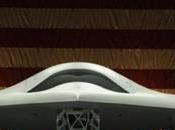
The X15 leaving a B52
Il momento più critico del volo spaziale è, probabilmente, la fase di lancio. Vincere la forza gravitazionale è un'impresa tutt'altro che semplice. I motori devono essere molto potenti; per questo motivo i combustibili utilizzati hanno un elevatissimo rendimento, ma per lo stesso motivo sono altamente pericolosi, e dannosi per l'ambiente. Senza contare i costi esorbitanti annessi a tutto il sistema per ogni singolo lancio.Sin dagli inizi dell'epopea spaziale si è sempre cercato una alternativa valida al "razzo lanciato da terra", e l'idea di lanciare i vettori direttamente da una certa altitudine, è stata presa in esame più e più volte. L'idea è piuttosto semplice: se si porta il razzo a una certa altitudine con un aereo convenzionale, a quel punto sarà meno onerosa la spesa in energia per poter raggiungere l'orbita.

The Pegasus on a L-1011 TriStar
Nei primi anni sessanta si collaudava l'X15, ovvero un aereo-razzo prototipale che veniva lanciato da un bombardiere B52 riadattato. Nei primi anni novanta fu sviluppato il Pegasus, ovvero un razzo dotato di piccole ali capace di decollare direttamente dal ventre di un Lockheed TriStar. Oggi l'idea torna nuovamente in auge, prima con l'annuncio a fine 2011 dello sviluppo del sistema Stratolaunch (di cui ho scritto qui), poi con la rivelazione che il Virgin Galactic, o per meglio dire il suo lanciatore WhiteKnight 2, sarà in grado di lanciare sia la navetta commerciale con equipaggio, sia un vettore cargo chiamato LauncherOne (qui).Questo sistema potrebbe risultare vincente nelle applicazioni che richiedono il lancio di materiali poco pesanti, come i piccoli satelliti di telecomunicazioni, gps, e simili. Meno conveniente per i carichi pesanti, visto il limite di portata che i vettori tradizionali hanno necessariamente.

Il WhiteKnight 2 with a LauncheOne.
The most critical situation in a space flight is, probably, the starting launch from Earth. It's not easy to win the gravity force. The engines must be powerful; for this reason the fuels must have a high energy power, and because of this, the fuels are really dangerous, and really polluting. And I'm not making count on the expenses needed for each one of this kind of launches. Since the start of the space conquest, scientist have spent a lot of time on this problem, and there was... there is... an idea that turned good so many times since today. I'm talking about the Air Launch System. This idea is simple: If you bring the rocket in air with a conventional airplane, next you have to spend less power to send it to the orbit.The Stratolaunch System
In the early sixties NASA was working on the X15, a sperimental rocket plane launched by a B52 in flight. In the nineties was developed the Pegasus, a commercial rocket capable to send satellites in the Low Orbit using the Air Launch System. It had small wings and was launched by a Lockheed TriStar. Today the idea comes back again, firstly with the announce of the studying of the new Stratolaunch system (I've talked about it here), and then with the revelation of Virgin Galactic about the double capability of the WhiteKnight 2 to launch both a manned space capsule, and also a commercial satellite carrier called LauncherOne (here).







